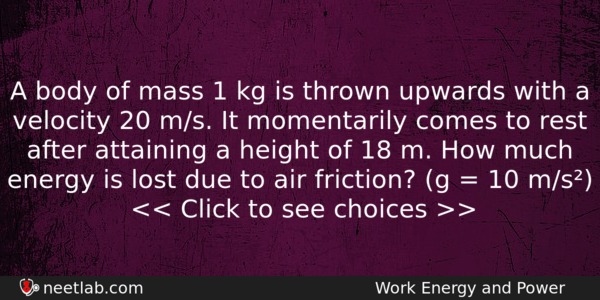| ⇦ | 
| ⇨ |
A body of mass 1 kg is thrown upwards with a velocity 20 m/s. It momentarily comes to rest after attaining a height of 18 m. How much energy is lost due to air friction? (g = 10 m/s²)
Options
(a) 30 J
(b) 40 J
(c) 10 J
(d) 20 J
Correct Answer:
20 J
Explanation:
When the body is thrown upwards. its K.E is converted into P.E. The loss of energy due to air friction is the difference of K.E and P.E
1/2 mv² – mgh = 1/2 x 1 x 400 – 1 x 18 x 10
= 200 – 180 = 20 J
Related Questions: - A Carnot engine, having an efficiency of η=1/10 as heat engine, is used
- A current of 5 A is passing through a metallic wire of cross-sectional area 4×10⁻⁶ m².
- If the value of potential in an A.C circuit is 10 V, the peak value of potential is
- For a given velocity, a projectile has the same range R for two angles of projection.
- Two spherical nuclei have mass numbers 216 and 64 with their radii R₁ and R₂,
Topics: Work Energy and Power
(94)
Subject: Physics
(2479)
Important MCQs Based on Medical Entrance Examinations To Improve Your NEET Score
- A Carnot engine, having an efficiency of η=1/10 as heat engine, is used
- A current of 5 A is passing through a metallic wire of cross-sectional area 4×10⁻⁶ m².
- If the value of potential in an A.C circuit is 10 V, the peak value of potential is
- For a given velocity, a projectile has the same range R for two angles of projection.
- Two spherical nuclei have mass numbers 216 and 64 with their radii R₁ and R₂,
Topics: Work Energy and Power (94)
Subject: Physics (2479)
Important MCQs Based on Medical Entrance Examinations To Improve Your NEET Score
18000+ students are using NEETLab to improve their score. What about you?
Solve Previous Year MCQs, Mock Tests, Topicwise Practice Tests, Identify Weak Topics, Formula Flash cards and much more is available in NEETLab Android App to improve your NEET score.
Share this page with your friends

Leave a Reply